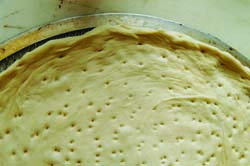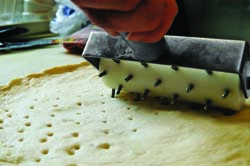How to prevent my pizza crust from bubbling in the oven?
I hold a special place in my heart for bubbles and blisters on pizza crusts — because this was the first problem I ever worked on.
To prevent them, what you need to concentrate on are dough temperature and fermentation time. In studies that we have conducted, we found that fresh dough exhibited the most pronounced tendency to bubble. But as we allowed the dough to ferment prior to forming and baking, the severity of bubbles began to decrease. With normal yeast levels (0.375 percent instant dry yeast, 0.5 percent active dry yeast, or 1.25 percent compressed/fresh yeast), and a finished (mixed) dough temperature in the 80 to 85F range, the bubbles are minimized after 2.5 hours of fermentation time at ambient temperature (approximately 70F). Longer fermentation times do not result in any further reduction in bubbles.
However, if you take the proper storage steps, you can pretty much eliminate bubbles. Start by taking the dough balls immediately after scaling and balling and place them in dough boxes, cross-stacked for two hours. Be sure to wipe them with salad oil to prevent them from drying out in the cooler. After two hours, downstack them and allow them to ferment overnight. Allow them to sit at room temperature for two hours before you use them and you’re ready to go.




Lastly, there is the dough docker. Dough dockers are designed to help control bubbling. But they don’t do anything to prevent it, or address the problem at its root cause. If you do happen to have one of those doughs that just seems to have a penchant for bubbling, the dough docker might prove to be your salvation. But, first, see if you can address the problem and eliminate it from your dough.
The late Tom Lehmann was a former director at the American Institute of Baking in Manhattan, Kansas and Pizza Today’s longstanding resident dough expert.
>> Explore answers to more common pizza dough questions in Troubleshooting your Pizza Dough: What’s wrong with my pizza dough? <<



